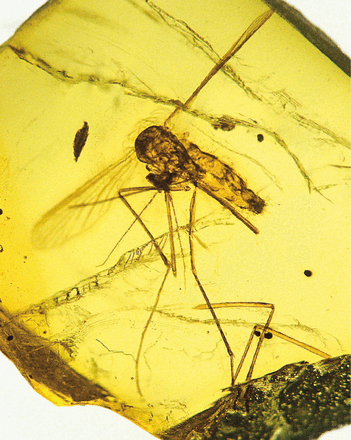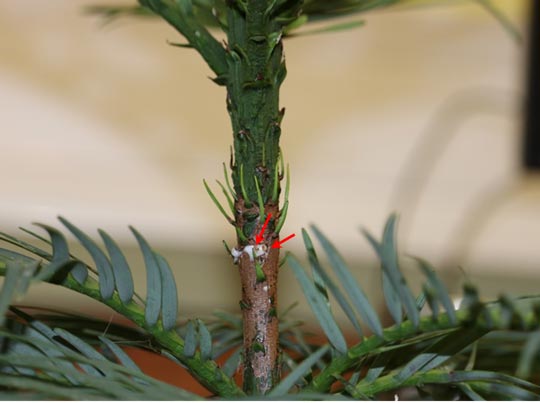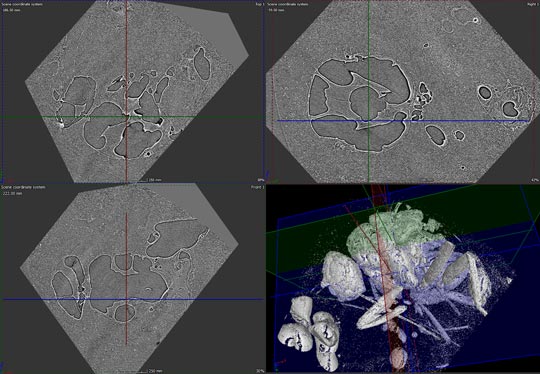Preservation Bias in Amber Fossilisation Examined
Fossils preserved in amber can give scientists unique insights into ancient ecosystems. Petrified tree resin can provide a record of some of the smaller members of a prehistoric woodland habitat such as the insects, mites and spiders. Spores and pollen grains trapped inside a nodule allow palaeobotanists the opportunity to assess the composition of the flora of a 100-million-year-old Cretaceous tropical forest, but all may not be as it seems. Fossils in amber appear, on their surface, to be perfectly preserved, which in turn suggests that the amber fossil record is perfect and unbiased. This is not the case, all that glitters inside an amber nodule may not be hidden palaeontological treasure.
A Mosquito Preserved in Amber – But How Much of the Insect is There?

Picture credit: Oregon State University
Fossils Preserved in Amber
However, recent advances in three-dimensional imaging techniques, specifically synchrotron tomography, have allowed researchers to look inside amber-entombed fossils and observe that preservation is highly variable. Many specimens are lacking some or all internal soft tissues, and some specimens are even lacking the more decay-resistant cuticle and are simply empty moulds stained in a life-like colour by remnant organic carbon.
With so many amazing discoveries being made, particularly in burmite from Myanmar, a team of scientists set about examining the amber fossil record in order to assess any potential preservation bias that might exist, with a focus on prehistoric insects.
In the project, the researchers used a serious of laboratory experiments to test the effect of three variables, resin (the un-fossilised precursor to amber) chemistry, gut biota, and dehydration prior to entombment, on the decay of a fruit fly engulfed in resin to better understand the controls on the fossil record of insects in amber.
The team discovered that resin chemistry has a large effect on decay: flies entombed in Wollemia (W. nobilis) tree resin retained essentially all of their external and internal morphology even after one and a half years, whereas flies entombed in Pinus (Scots Pine P. sylvestris) tree resin, were nothing but empty moulds after the same length of time.
Fruit Flies Being Entombed in Tree Resin

Gut biota had a smaller effect on decay: flies with an intact gut microbiota showed more rapid decay, as indicated by more extensive production of decay gases, than flies that were treated with an antibiotic prior to entombment. Dehydration prior to entombment also enhanced decay, presumably because resin has very effective decay-inhibiting properties, and therefore any delay in embedding a carcass in resin enhances decay. These three variables influence the preservation of fossils in amber, and therefore can impart a bias on the fossil record of insects in amber. Writing in the academic journal “PLOS One”, the researchers concluded that, in particular, resin chemistry and gut biota may strongly influence the amber fossil record.
Synchrotron Images and a Three-Dimensional Reconstruction of the Fruit Fly Being Constructed

The Chemistry of Tree Resin
Resin chemistry is the most likely control on whether or not a specific fossil site preserves the most decay-prone morphological features on the most decay-prone components of an ecosystem. This could be a particularly confounding bias in the amber fossil record because the composition of the herbivore fauna (including herbivorous insects) is thought to be one control on the composition of resin chemistry; therefore, the composition of a faunal assemblage may influence whether or not it fossilises in amber. Gut biota variations may also influence preservational variation, particularly among amber sites or specimens with similar chemistry.
Most importantly, the amber fossil record should not be viewed as a perfect record of an ancient ecosystem. Rather, it must be viewed with a critical eye, and an understanding that information about an extinct organism can be lost during fossilisation in amber.
The scientific paper: “Unlocking Preservation Bias in the Amber Insect Fossil Record Through Experimental Decay” by Victoria E. McCoy , Carmen Soriano, Mirko Pegoraro, Ting Luo, Arnoud Boom, Betsy Foxman and Sarah E. Gabbott published in PLOS One.
Link to the paper open access paper: The Scientific Paper.
Everything Dinosaur would like to thank Victoria McCoy (School of Geography, Geology and Environment, University of Leicester and the Steinmann-Institut für Geologie, Mineralogie und Paläontologie, Universität Bonn, Bonn, Germany), for her assistance with the compilation of this article.
Visit the Everything Dinosaur website: Everything Dinosaur.






Very interesting article, you could perhaps factor in the different atmosphere of the earth during the time of preservation?